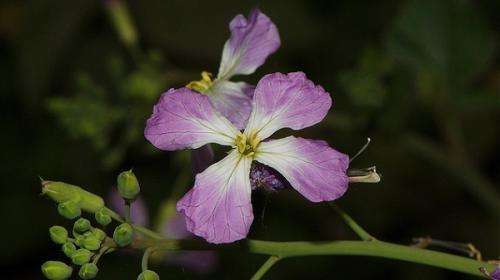Sight set on resilient weed

The first glyphosate-resistant wild radish (Raphanus raphanistrum L.) populations have been identified by researchers from the Australian Herbicide Resistance Initiative (AHRI) at The University of Western Australia.
Resistance was confirmed following tests on plants grown from seeds obtained near Mingenew and Carnamah in WA's grainbelt, where wild radish was not controlled following repeated glyphosate applications.
At the recommended glyphosate dose for wild radish control in Australia, the Mingenew and Carnamah-derived populations had survival rates of 63 per cent and 86 per cent respectively.
Dose response on the progeny of each population showed that glyphosate resistance is inherited, with progeny requiring three-and-a-half to four-and-a-half times more glyphosate for control compared to the three known susceptible populations in the study.
"Wild radish is the most economically damaging weed in Australian grain cropping, and is listed in the top 180 worst weeds worldwide," AHRI PhD student Michael Ashworth says.
"The identification of these glyphosate-resistant wild radish populations is another example of the significant threat that glyphosate resistance and weed evolution pose to the sustainability of modern farming systems.
"Our findings serve to re-emphasise the importance of diverse weed control strategies.
"Proactive and integrated measures for resistance management need to be developed to diversify control measures away from glyphosate and advance the use of non-herbicidal techniques."
Several factors make wild radish problematic for WA farmers, including its ability to germinate over a wide range of environmental conditions and its flexible life cycle.
The species is also a prolific seed producer, whose innately dormant seeds contribute to a persistent soil seed bank.
Previous research undertaken by AHRI researchers demonstrates that intercepting weed seeds at harvest can have a major impact on weed populations, particularly wild radish.
Capturing seed through chaff at harvest can result in annual seed loses of 60 to 80 per cent, which can see very large seed banks (>1000 seed/m2) reduced to modest ones (<100 seed/m2) in just four years.
The use of these techniques combined with other diverse tactics such as herbicide rotation and highly competitive crops has been shown to significantly reduce weed seed banks.
AHRI Director Professor Stephen Powles says that lower seed banks allow for easier and more effective weed control with a reduced risk for the evolution of herbicide resistance.
"Don't rely solely on glyphosate, and maintain diversity in weed management techniques to provide glyphosate longevity and sustain future harvests," Prof Powles says.
To date 25 glyphosate-resistant weed species have been confirmed worldwide.
Provided by Science Network WA



















